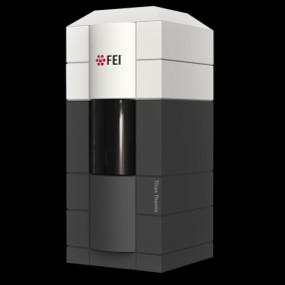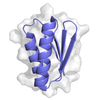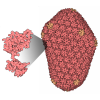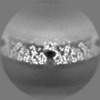+ Open data
Open data
- Basic information
Basic information
| Entry |  | |||||||||
|---|---|---|---|---|---|---|---|---|---|---|
| Title | HERV-K Gag immature lattice | |||||||||
 Map data Map data | ||||||||||
 Sample Sample |
| |||||||||
 Keywords Keywords | C6 symmetry / endogenous retrovirus / VIRUS LIKE PARTICLE | |||||||||
| Function / homology |  Function and homology information Function and homology informationviral process / nucleic acid binding / structural molecule activity / zinc ion binding / plasma membrane Similarity search - Function | |||||||||
| Biological species |  Human endogenous retrovirus K Human endogenous retrovirus K | |||||||||
| Method | subtomogram averaging / cryo EM / Resolution: 3.2 Å | |||||||||
 Authors Authors | Krebs A-S / Liu H-F / Zhou Y / Rey JS / Levintov L / Perilla JR / Bartesaghi A / Zhang P | |||||||||
| Funding support |  United Kingdom, 1 items United Kingdom, 1 items
| |||||||||
 Citation Citation |  Journal: bioRxiv / Year: 2023 Journal: bioRxiv / Year: 2023Title: Molecular architecture and conservation of an immature human endogenous retrovirus. Authors: Anna-Sophia Krebs / Hsuan-Fu Liu / Ye Zhou / Juan S Rey / Lev Levintov / Juan Shen / Andrew Howe / Juan R Perilla / Alberto Bartesaghi / Peijun Zhang /   Abstract: A significant part of the human genome consists of endogenous retroviruses sequences. Human endogenous retrovirus K (HERV-K) is the most recently acquired endogenous retrovirus, is activated and ...A significant part of the human genome consists of endogenous retroviruses sequences. Human endogenous retrovirus K (HERV-K) is the most recently acquired endogenous retrovirus, is activated and expressed in many cancers and amyotrophic lateral sclerosis and possibly contributes to the aging process. To understand the molecular architecture of endogenous retroviruses, we determined the structure of immature HERV-K from native virus-like particles (VLPs) using cryo-electron tomography and subtomogram averaging (cryoET STA). The HERV-K VLPs show a greater distance between the viral membrane and immature capsid lattice, correlating with the presence of additional peptides, SP1 and p15, between the capsid (CA) and matrix (MA) proteins compared to the other retroviruses. The resulting cryoET STA map of the immature HERV-K capsid at 3.2 Å resolution shows a hexamer unit oligomerized through a 6-helix bundle which is further stabilized by a small molecule in the same way as the IP6 in immature HIV-1 capsid. The HERV-K immature CA hexamer assembles into the immature lattice via highly conserved dimmer and trimer interfaces, whose interactions were further detailed through all-atom molecular dynamics simulations and supported by mutational studies. A large conformational change mediated by the flexible linker between the N-terminal and the C-terminal domains of CA occurs between the immature and the mature HERV-K capsid protein, analogous to HIV-1. Comparison between HERV-K and other retroviral immature capsid structures reveals a highly conserved mechanism for the assembly and maturation of retroviruses across genera and evolutionary time. | |||||||||
| History |
|
- Structure visualization
Structure visualization
| Supplemental images |
|---|
- Downloads & links
Downloads & links
-EMDB archive
| Map data |  emd_16511.map.gz emd_16511.map.gz | 23.9 MB |  EMDB map data format EMDB map data format | |
|---|---|---|---|---|
| Header (meta data) |  emd-16511-v30.xml emd-16511-v30.xml emd-16511.xml emd-16511.xml | 15.1 KB 15.1 KB | Display Display |  EMDB header EMDB header |
| Images |  emd_16511.png emd_16511.png | 132 KB | ||
| Filedesc metadata |  emd-16511.cif.gz emd-16511.cif.gz | 6 KB | ||
| Others |  emd_16511_half_map_1.map.gz emd_16511_half_map_1.map.gz emd_16511_half_map_2.map.gz emd_16511_half_map_2.map.gz | 32.4 MB 32.4 MB | ||
| Archive directory |  http://ftp.pdbj.org/pub/emdb/structures/EMD-16511 http://ftp.pdbj.org/pub/emdb/structures/EMD-16511 ftp://ftp.pdbj.org/pub/emdb/structures/EMD-16511 ftp://ftp.pdbj.org/pub/emdb/structures/EMD-16511 | HTTPS FTP |
-Validation report
| Summary document |  emd_16511_validation.pdf.gz emd_16511_validation.pdf.gz | 757.4 KB | Display |  EMDB validaton report EMDB validaton report |
|---|---|---|---|---|
| Full document |  emd_16511_full_validation.pdf.gz emd_16511_full_validation.pdf.gz | 757 KB | Display | |
| Data in XML |  emd_16511_validation.xml.gz emd_16511_validation.xml.gz | 12.3 KB | Display | |
| Data in CIF |  emd_16511_validation.cif.gz emd_16511_validation.cif.gz | 14.4 KB | Display | |
| Arichive directory |  https://ftp.pdbj.org/pub/emdb/validation_reports/EMD-16511 https://ftp.pdbj.org/pub/emdb/validation_reports/EMD-16511 ftp://ftp.pdbj.org/pub/emdb/validation_reports/EMD-16511 ftp://ftp.pdbj.org/pub/emdb/validation_reports/EMD-16511 | HTTPS FTP |
-Related structure data
| Related structure data |  8c9mMC M: atomic model generated by this map C: citing same article ( |
|---|---|
| Similar structure data | Similarity search - Function & homology  F&H Search F&H Search |
- Links
Links
| EMDB pages |  EMDB (EBI/PDBe) / EMDB (EBI/PDBe) /  EMDataResource EMDataResource |
|---|---|
| Related items in Molecule of the Month |
- Map
Map
| File |  Download / File: emd_16511.map.gz / Format: CCP4 / Size: 64 MB / Type: IMAGE STORED AS FLOATING POINT NUMBER (4 BYTES) Download / File: emd_16511.map.gz / Format: CCP4 / Size: 64 MB / Type: IMAGE STORED AS FLOATING POINT NUMBER (4 BYTES) | ||||||||||||||||||||||||||||||||||||
|---|---|---|---|---|---|---|---|---|---|---|---|---|---|---|---|---|---|---|---|---|---|---|---|---|---|---|---|---|---|---|---|---|---|---|---|---|---|
| Projections & slices | Image control
Images are generated by Spider. | ||||||||||||||||||||||||||||||||||||
| Voxel size | X=Y=Z: 1.503 Å | ||||||||||||||||||||||||||||||||||||
| Density |
| ||||||||||||||||||||||||||||||||||||
| Symmetry | Space group: 1 | ||||||||||||||||||||||||||||||||||||
| Details | EMDB XML:
|
-Supplemental data
-Half map: #2
| File | emd_16511_half_map_1.map | ||||||||||||
|---|---|---|---|---|---|---|---|---|---|---|---|---|---|
| Projections & Slices |
| ||||||||||||
| Density Histograms |
-Half map: #1
| File | emd_16511_half_map_2.map | ||||||||||||
|---|---|---|---|---|---|---|---|---|---|---|---|---|---|
| Projections & Slices |
| ||||||||||||
| Density Histograms |
- Sample components
Sample components
-Entire : Human endogenous retrovirus K
| Entire | Name:  Human endogenous retrovirus K Human endogenous retrovirus K |
|---|---|
| Components |
|
-Supramolecule #1: Human endogenous retrovirus K
| Supramolecule | Name: Human endogenous retrovirus K / type: virus / ID: 1 / Parent: 0 / Macromolecule list: all / Details: Gag protein, not cleaved / NCBI-ID: 45617 / Sci species name: Human endogenous retrovirus K / Sci species strain: HERV-K con / Virus type: VIRUS-LIKE PARTICLE / Virus isolate: OTHER / Virus enveloped: Yes / Virus empty: Yes |
|---|---|
| Host (natural) | Organism:  Homo sapiens (human) Homo sapiens (human) |
| Virus shell | Shell ID: 1 / Name: CA-NC |
-Macromolecule #1: Gag protein
| Macromolecule | Name: Gag protein / type: protein_or_peptide / ID: 1 / Number of copies: 6 / Enantiomer: LEVO |
|---|---|
| Source (natural) | Organism:  Human endogenous retrovirus K Human endogenous retrovirus K |
| Molecular weight | Theoretical: 74.069219 KDa |
| Recombinant expression | Organism:  Homo sapiens (human) Homo sapiens (human) |
| Sequence | String: MGQTKSKIKS KYASYLSFIK ILLKRGGVKV STKNLIKLFQ IIEQFCPWFP EQGTLDLKDW KRIGKELKQA GRKGNIIPLT VWNDWAIIK AALEPFQTEE DSVSVSDAPG SCIIDCNENT RKKSQKETEG LHCEYVAEPV MAQSTQNVDY NQLQEVIYPE T LKLEGKGP ...String: MGQTKSKIKS KYASYLSFIK ILLKRGGVKV STKNLIKLFQ IIEQFCPWFP EQGTLDLKDW KRIGKELKQA GRKGNIIPLT VWNDWAIIK AALEPFQTEE DSVSVSDAPG SCIIDCNENT RKKSQKETEG LHCEYVAEPV MAQSTQNVDY NQLQEVIYPE T LKLEGKGP ELVGPSESKP RGTSPLPAGQ VPVTLQPQKQ VKENKTQPPV AYQYWPPAEL QYRPPPESQY GYPGMPPAPQ GR APYPQPP TRRLNPTAPP SRQGSELHEI IDKSRKEGDT EAWQFPVTLE PMPPGEGAQE GEPPTVEARY KSFSIKMLKD MKE GVKQYG PNSPYMRTLL DSIAHGHRLI PYDWEILAKS SLSPSQFLQF KTWWIDGVQE QVRRNRAANP PVNIDADQLL GIGQ NWSTI SQQALMQNEA IEQVRAICLR AWEKIQDPGS TCPSFNTVRQ GSKEPYPDFV ARLQDVAQKS IADEKARKVI VELMA YENA NPECQSAIKP LKGKVPAGSD VISEYVKACD GIGGAMHKAM LMAQAITGVV LGGQVRTFGG KCYNCGQIGH LKKNCP VLN KQNITIQATT TGREPPDLCP RCKKGKHWAS QCRSKFDKNG QPLSGNEQRG QPQAPQQTGA FPIQPFVPQG FQGQQPP LS QVFQGISQLP QYNNCPPPQA AVQQ UniProtKB: Gag protein |
-Experimental details
-Structure determination
| Method | cryo EM |
|---|---|
 Processing Processing | subtomogram averaging |
| Aggregation state | particle |
- Sample preparation
Sample preparation
| Buffer | pH: 8 / Details: OptiPrep in STE buffer |
|---|---|
| Grid | Model: EMS Lacey Carbon / Material: COPPER / Mesh: 300 / Pretreatment - Type: GLOW DISCHARGE |
| Vitrification | Cryogen name: ETHANE / Instrument: LEICA EM GP |
- Electron microscopy
Electron microscopy
| Microscope | FEI TITAN KRIOS |
|---|---|
| Specialist optics | Energy filter - Name: TFS Selectris / Energy filter - Slit width: 5 eV |
| Image recording | Film or detector model: FEI FALCON IV (4k x 4k) / Average exposure time: 1.17 sec. / Average electron dose: 3.1 e/Å2 |
| Electron beam | Acceleration voltage: 300 kV / Electron source:  FIELD EMISSION GUN FIELD EMISSION GUN |
| Electron optics | Illumination mode: FLOOD BEAM / Imaging mode: BRIGHT FIELD / Nominal defocus max: 5.0 µm / Nominal defocus min: 2.0 µm |
| Experimental equipment |  Model: Titan Krios / Image courtesy: FEI Company |
- Image processing
Image processing
| Final reconstruction | Applied symmetry - Point group: C6 (6 fold cyclic) / Resolution.type: BY AUTHOR / Resolution: 3.2 Å / Resolution method: FSC 0.143 CUT-OFF / Number subtomograms used: 188111 |
|---|---|
| Extraction | Number tomograms: 124 / Number images used: 274994 |
| Final angle assignment | Type: OTHER |
 Movie
Movie Controller
Controller






 Z (Sec.)
Z (Sec.) Y (Row.)
Y (Row.) X (Col.)
X (Col.)




































